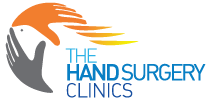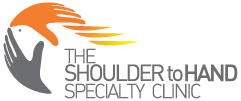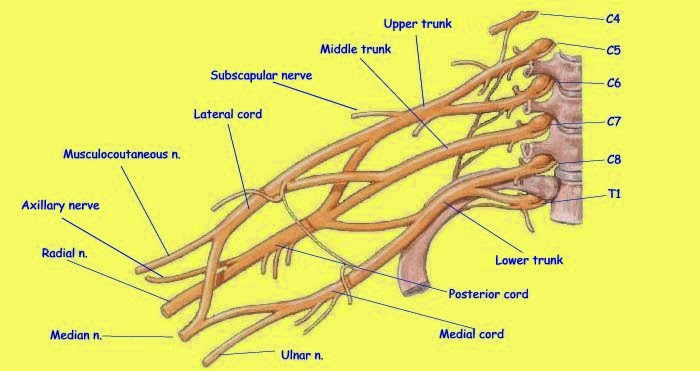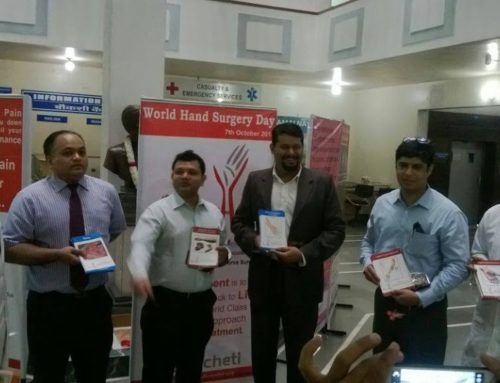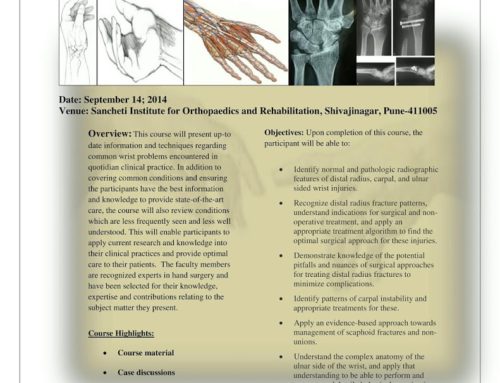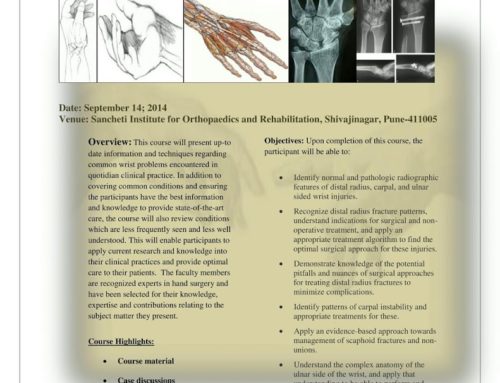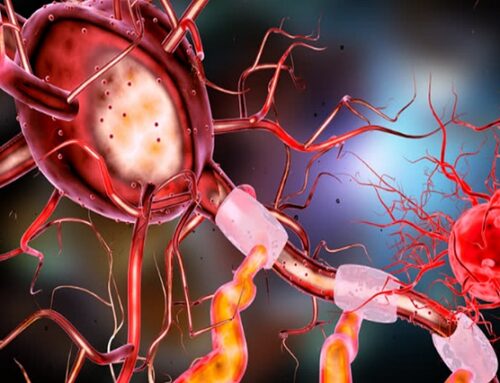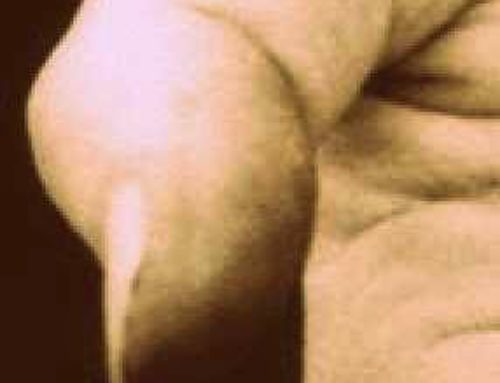The Hand Surgery Clinic offers comprehensive treatment for Brachial Plexus and Peripheral Nerve Injuries
Praveen (name changed), a 26 year old computer engineer, met with a motorcycle accident on a rainy day last year. His world came crashing down when he realized that his right limb was completely paralyzed from shoulder down to the hand.
Doctors in Praveen’s hometown suggested that it might just be a temporary problem and that he would probably recover use of his arm on his own in time to come. Four months later, Praveen had yet to see any improvement. He was anxious to know what was wrong with his hand and what could be done to recover his hand function. He set out to hunt for answers. After physical therapy and a battery of tests, a physician suggested that Praveen should visit The Hand Surgery Clinic for further evaluation and counseling.
Seeking answers at The Hand Surgery Clinic
A thorough clinical evaluation by the team of Brachial Plexus surgeons at The Hand Surgery Clinic revealed that Praveen had suffered a severe injury resulting in tearing of several nerves (called the Brachial Plexus) in his neck at the time of injury. The torn nerves were unable to provide electrical stimulus to the muscles in his hand and limb, resulting in paralysis of the entire upper limb. Without surgery, he would never be able to use his limb.
The Brachial Plexus team at The Hand Surgery Clinic recommended the surgery be completed soon because the nerves needed time to heal before his hand and arm muscles died completely.
Within a month after his visit to The Hand Surgery Clinic, Praveen underwent surgery. Nerve grafts were used to restore nerve function to his badly damaged brachial plexus nerves. The surgical team harvested a nerve from Praveen’s leg, one that would not cause any additional problems or side effects. The nerve from the leg was then attached to the nerves in Praveen’s neck and shoulder to repair the tear.
“Surgery is scary option for the patient and his family,” says Praveen’s father. “But we had to take this decision to give Praveen a chance to use his hand and arm.”
When Praveen began noticing small shoulder and elbow movements in the months after the surgery, it became clear that he had won the first leg of the race.Praveen’s surgery restored nerve activity in his shoulder and elbow, an imperative first step toward recovery. With it, Praveen gained use of his shoulder and elbow. However, Praveen did not gain use of his hand after the nerve graft surgery. The muscles of his hand were already too damaged from months of disuse to be re-innervated and achieve any function.
Praveen had surgery again in a year following his nerve graft surgery. His wrist was fused/blocked to stabilize the floppy wrist. In addition a tendon from elsewhere in his arm was transferred to the damaged tendons of the hand to restore some finger and hand function.
Today, 2 years after his surgeries, Praveen has started leading a more meaningful life. Because of his surgeries and additional physical therapy, Praveen now has almost full use of this shoulder and elbow and is able to use his injured hand to assist his normal hand in performing most of the activities of daily living.
Praveen is gainfully employed now in a software company. “I am happy to be able to get back to life and be independent” says Praveen.
Information about Brachial Plexus Injuries-
What is the Brachial Plexus?
The brachial plexus is a network of nerves that originate near the neck and shoulder. These nerves begin at the spinal cord in the neck and control the hand, wrist, elbow, and shoulder. Nerves are the electrical wiring system in all people that carry messages from the brain to the rest of the body. A nerve is like an electrical cable wrapped in insulation.
Motor nerves carry messages from the brain to muscles to make the body move. Sensory nerves carry messages to the brain from different parts of the body to signal pain, pressure, and temperature. The brachial plexus has nerves that are both motor and sensory. Brachial plexus injuries most commonly occur after an accident, sports injury or during childbirth, and can leave the arm without function.
What happens when the brachial plexus is injured?
The network of nerves is fragile and can be damaged by pressure, stretching, or cutting. Stretching can occur when the head and neck are forced away from the shoulder, such as might happen in a fall off a motorcycle. If severe enough, the nerves can actually avulse, or tear out of, their roots in the neck. Pressure could occur from crushing of the brachial plexus between the collarbone and first rib, or swelling in this area from injured muscles or other structures.
Injury to a nerve can stop signals to and from the brain, preventing the muscles of the arm and hand from working properly, and causing loss of feeling in the area supplied by the injured nerve. When a nerve is cut, both the nerve and the insulation are broken. Pressure or stretching injuries can cause the fibers that carry the information to break and stop the nerve from working, without damaging the cover.
When nerve fibers are cut, the end of the fiber farthest from the brain dies, while the insulation stays healthy. The end that is closest to the brain does not die, and after some time may begin to heal. If the insulation was not cut, new fibers may grow down the empty cover of the tissue until reaching a muscle or sensory receptor.
Some brachial plexus injuries are minor and will completely recover in several weeks. Other injuries are severe enough that some permanent disability involving the arm can be expected.
How is brachial plexus treated?
Many brachial plexus injuries can recover with time and therapy. The time for recovery can be weeks or months. When an injury is unlikely to improve, several surgical techniques can be used to improve the recovery. To help decide which injuries are likely to recover, your physician will rely upon multiple examinations of the arm and hand to check the strength of muscles and sensation. Additional testing, such as an MRI scan, or CT scan/myelography, may be used to visually evaluate the brachial plexus. A Nerve Conduction Study/Electromyogram (NCS/EMG), a test that measures the electrical activity transmitted by nerves and muscles, may also be performed. In some cases, repair of the nerves or transfer of undamaged nerves from other areas of the body can be performed. In other cases, transfer of functioning muscles (tendon transfer) to take over areas of lost function can be performed.
What is my role in recovery and what kind of results can I expect?
The patient must do several things to keep up muscle activity and prevent the joints from getting stiff. Your doctor may recommend therapy to keep joints flexible. If the joints become stiff, they will not work even after muscles begin to work again. When a sensory nerve has been injured, the patient must be extra careful not to burn or cut fingers since there is no feeling in the affected area. After the nerve has recovered, the brain gets lazy and a procedure called sensory re-education may be needed to improve feeling in the hand or finger. Your doctor will recommend the appropriate therapy based on the nature of your injury.
Factors that may affect results after brachial plexus injury include age and the type, severity, and location of the injury. Though brachial plexus injuries may result in lasting problems for the patient, care by a physician and proper therapy can maximize function.
Why choose The Brachial Plexus and Peripheral Nerve Injury Center at The Hand Surgery Clinics?
- Experience. The Brachial Plexus and Peripheral Nerve Injury Center at the Hand Surgery Clinics is a leading center for surgery to repair brachial plexus injuries. Our surgeons are extensively trained and perform these delicate surgeries regularly.
- Special expertise. Our surgeons use advanced microsurgical techniques (including nerve and muscle transfers) to repair damaged brachial plexus nerves, muscles and tendons.
- Team approach. Our team of Brachial Plexus and Peripheral Nerve surgeons, neurologists,physiotherapists and orthotists work together to provide the best outcomes for our patients.
The Brachial Plexus and Peripheral Nerve Injury (BPPNI) center is a cooperative, interdisciplinary center for evaluation and management of brachial plexus and peripheral nerve injuries.It also serves as an educational resource for the public and healthcare professionals, and a research center dedicated to improving clinical outcomes for patients with brachial plexus injuries. A full spectrum of adult and children’s brachial plexus surgery, including complex peripheral nerve surgery, is offered at the Brachial Plexus and Peripheral Nerve Injury (BPPNI) center of The Hand Surgery Clinics. The Brachial Plexus and Peripheral Nerve Injury center is composed of health care professionals with specialized skills and interests relevant to brachial plexus and peripheral nerve injuries. Patients are assessed and treated by a comprehensive, multidisciplinary team to achieve the most optimum results and outcomes.
